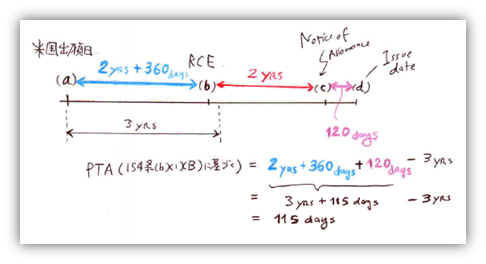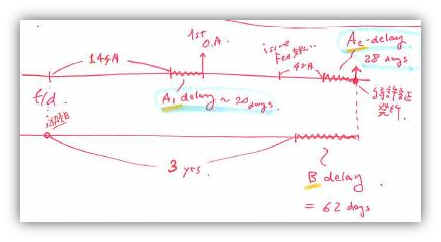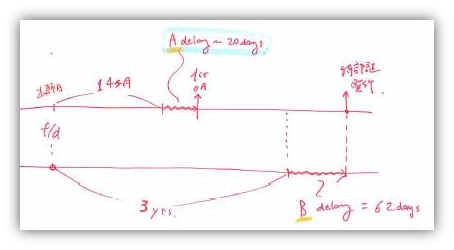
|
Novartis
v. Lee (Director of USPTO) Fed.
Cir. Jan. 15, 2014 RCE後登録となった特許に対するUSPTOによるPTAの計算の仕方は間違い
Tatsuo
YABE January 23, 2014 |
|
Subject:
RCE後に登録された米国特許に対する3Yearルールに基づくPTA(有効期限の延長)の算出方法
Novartis社はUSPTOに対してPTAの計算の仕方(3Yearルールの適応の仕方)が間違っているとして不服を唱えており、地裁を経てCAFCで決定された。 判決文(原文)
1995年以前、米国特許は特許証が発行されてから17年の特許有効期間が与えられていた。 1995年6月8日以降の米国出願に対して出願日より20年という有効期間に変わった。 然るに特許庁の審査が3年以上経過すると(出願人側には遅れの原因がなくとも)従前は17年間与えられていた有効期間が減少することになるので、その不満に対して1999年の米国発明者保護法の中で154条に(b)項が追加された。 同条項によると出願日から第1回目のアクションが出るまでに14か月を超えた場合にはその遅れ日数、出願人の応答書提出日から4ヶ月を超えて特許庁がOAを発行する場合にはその遅れ日数、さらに、登録料の支払いから4ヶ月を超えて特許証が発行される場合にはその遅れ日数がそれぞれ合算されPTA(Patent
Term Adjustment)として20年の期限満了日に追加される(以下14-4-4ルールと呼ぶ)。 同条項によるとさらに、出願日より3年を超えて特許証が発行される場合にもその遅れ日数がPTAとして加算される(以下3Yearルールと呼ぶ)と規定されている。 尚、154条(b)(2)において上記14-4-4ルールに該当する遅れ期間と上記3Yearルールに該当する遅れ期間が重複する場合には、重複部分を加算しないと規定されている。 尚、154条(b)(2)の解釈は2010年のWyeth判決(Wyeth
v. Kappos: Fed. Cir. 2010)でクリアにされた。(本事件の後に概説している)
今回の事件は154条(b)(1)(B)(i)に関する。 即ち、154条(b)(1)(B)(i)では、「RCE審査に要した期間は上記3Yearルールの対象とはしない」と規定されている。 本事件の争点は、「RCE審査に要した期間」とはRCE後の許可可能通知発効日から特許証発効日までの期間を含むか否かである。
USPTOは上記期間(許可可能通知から特許証発行)もRCE審査に要した期間に含むと解釈し、上記3Yearルールの判断の対象としないという理解でPTAを計算していた。
この度、CAFCはUSPTOの理解が間違っていると判断した。 即ち、RCEをいつ実施したか(出願日より3年以内にRCE実施か否か)に関係なくRCE後の許可可能通知から特許証発行までの期間も上記3Yearルールの判断(154条(b)(1)(B)の計算)に使うと判断した。 拠って、以下のような状況のときに差が出てくる。
(EXAMPLE) 以下の状況で3Yearルール(“154条(b)(1)(B)”)に基づくPTAは?
説明を簡略化するために、14-4-4ルールに該当するPTOの遅れはなく、また、出願人側における遅れ(例:拒絶通知に対する応答が期限内)が一切ないものと仮定する。
|
|

|
|
(a)
US Filing Date (米国出願日)
– Day 1
(b)
Date of Filing RCE (RCE申請日) –
2 Years + 360
Days from (a) day;
(c)
Notice of Allowance (許可可能通知発効日)– 4 Years + 360 Days
from (a) day;
(d)
Issuance Date of Patent(特許証発効日)– 4 Years + 480 Days
from (a) day;
上記の場合に、154条(b)(1)(B)に基づくPTAは、(a)-(b)の期間と(c)-(d)の期間を足して3年を超えている日数とするのが正しい計算の仕方である。 即ち、2
Yeas + 360 Days + 120 Days = 2 Years + 480 Days (=
3 Years + 115 Days)から3年を引くと115日となる。
注意: 154条(b)(1)(B)(i)で規定されている、「RCE審査に要した期間は上記3Yearルールの対象とはしない」という「RCE審査に要した期間」とは上記(b)-(c)の期間であり、この期間は幾ら長くかかっていても3Yearルールの計算には入れない。
----------------------------------------------------------------
上記EXAMPLEにおいて、USPTOのこれまでの計算の仕方に依れば(b)-(d)の期間すべてを154条(b)(1)(B)の計算に入れていなかったので、
2 Yeas + 360 Days – 3 Years
はマイナスになるので154条(b)(1)(B)によるPTAは0になっていた。
本事件において、このUSPTOの計算の仕方は間違いであると判断された。
*******************************************************************
Wyeth
v. Kappos判決で決定された内容 (参考)
2010年1月7日にCAFCの判決(Wyeth
v. Kappos: USPTO director)でUSPTOのPTA(特許有効期限の延長)の計算式に間違いがあることが確認された。
争点をシンプルにするために、出願人側における遅れ(例:拒絶通知に対する応答が期限内)が一切ないものと想定し、説明します。
米国特許の有効期限は出願日から20年に切り替わり(1995年6月8日)、1999年11月28日に米国発明者保護法(American
Inventor's Protection Act:改正法案)が可決され、特許庁側の理由に起因する特許証発行の遅れに関してはその遅れた日数分を有効期限に付加しようという法律で、154条に規定されている。 同条文の概要は以下の通り:
154条(b)(1)(A) ⇒ A
Delayと称する。
所謂、14-4-4ルールと呼ばれたもので、出願後14ヶ月以内に第1回目の実体拒絶を出せない場合には、その遅れ日数を加算、出願人の応答に対して4ヶ月以内にアクションを出せない場合にはその遅れ日数を加算する; 登録料納付後4ヶ月以内に特許証を発行できない場合にはその遅れ日数を加算するなど。
出願後3年以内に特許証が発行されない場合にはその遅れ日数を加算する。
154条(b)(1)(B) ⇒ B
Delayと称する。
■ 正しいPTAの計算の仕方:
|
A Delayの総和とB
Delayをプラスし、B
Delayと A Delayの重なり部分をマイナスする。
(勿論、出願人側の遅れがあればそれをさらにマイナスする)
|
例1)
|

|
A=A1+A2=20+28=48日
B=62日
PTA=(A+B)−A2=(48+62)−28=82日
|
|
例2)
|

|
|
A=20日
B=62日
PTA=(A+B)−0=20+62=82日
|
■ 米国特許庁の今までの計算:
A DelayとB Delayのどちらか大きいほうをPTAとしていた。
|
拠って、
例1)の場合にはB>A1+A2、故に62日、
例2)の場合には、B>A,故に62日と計算していた。
|
*******************************************
|
上記のようにUSPTOの計算式は間違っていたので、USPTOは3月2日には完全にプログラムを修正することを確約し、以下の特許に対してのみ、無料でPTAの再計算をし、妥当な場合にはPTAを加算することをアナウンスした。
|
■ PTA再計算・加算の対象となる米国特許:
|
2010年3月2日までに登録(特許証発行)されたもので、登録後180日以内にPTA再計算をUSPTOに申請した場合
*************************************************************************************
参考:
§ 154. Contents and term of patent; provisional rights
(a) In General.—
(1) Contents.— Every
patent shall contain a short title of the invention and a grant to the patentee,
his heirs or assigns, of the right to exclude others from making, using,
offering for sale, or selling the invention throughout the United States or
importing the invention into the United States, and, if the invention is a
process, of the right to exclude others from using, offering for sale or selling
throughout the United States, or importing into the United States, products made
by that process, referring to the specification for the particulars thereof.
(2) Term.— Subject to
the payment of fees under this title, such grant shall be for a term beginning
on the date on which the patent issues and ending 20 years from the date on
which the application for the patent was filed in the United States or, if the
application contains a specific reference to an earlier filed application or
applications under section 120, 121, or 365 (c) of this title, from the date on
which the earliest such application was filed.
(3) Priority.— Priority
under section 119, 365 (a), or 365 (b) of this title shall not be taken into
account in determining the term of a patent.
(4) Specification and drawing.— A
copy of the specification and drawing shall be annexed to the patent and be a
part of such patent.
(b) Adjustment of Patent Term.—
(1) Patent term guarantees.—
(A) Guarantee of prompt patent and trademark office
responses.— Subject to the limitations under paragraph (2), if the
issue of an original patent is delayed due to the failure of the Patent and
Trademark Office to—
(i) provide at least one of the notifications under section
132 of this title or a notice of allowance under section 151 of this title not
later than 14 months after—
(I) the date on which an application was filed under section
111 (a) of this title; or
(II) the date on which an international application fulfilled
the requirements of section 371 of this title;
(ii) respond to a reply under section 132, or to an appeal
taken under section 134, within 4 months after the date on which the reply was
filed or the appeal was taken;
(iii) act on an
application within 4 months after the date of a decision by the Board of Patent
Appeals and Interferences under section 134 or 135 or a decision by a Federal
court under section 141, 145, or 146 in a case in which
allowable claims remain in the application; or
(iv) issue a patent within 4 months after the date on which the
issue fee was paid under section 151 and all outstanding requirements were
satisfied, the term of the patent shall be extended 1 day for each day after the
end of the period specified in clause (i), (ii), (iii), or (iv), as the case may
be, until the action described in such clause is taken.
(B) Guarantee of no more than 3-year application
pendency.— Subject to the limitations under paragraph (2), if the
issue of an original patent is delayed due to the failure of the United States
Patent and Trademark Office to issue a patent within 3 years after the actual
filing date of the application in the United States, not
including—
(i) any
time consumed by continued examination of the application requested by the
applicant under section 132 (b); (ß今回の事件の争点:継続審査で要した時間とは?)
(ii) any time consumed by a proceeding under section 135 (a),
any time consumed by the imposition of an order under section 181, or any time
consumed by appellate review by the Board of Patent Appeals and Interferences or
by a Federal court; or
(iii) any delay in
the processing of the application by the United States Patent and Trademark
Office requested by the applicant except as permitted by paragraph (3)(C), the
term of the patent shall be extended 1 day for each day after the end of that
3-year period until the patent is issued.
(C) Guarantee or adjustments for delays due to
interferences, secrecy orders, and
appeals.— Subject to
the limitations under paragraph (2), if the issue of an original patent is
delayed due to—
(i) a proceeding under section 135 (a);
(ii) the imposition of an order under section 181; or
(iii) appellate
review by the Board of Patent Appeals and Interferences or by a Federal court in
a case in which the patent was issued under a decision in the review reversing
an adverse determination of patentability, the term of the patent shall be
extended 1 day for each day of the pendency of the proceeding, order, or review,
as the case may be.
(2) Limitations.—
(A) In general.— To the extent that periods of delay attributable to grounds specified in
paragraph (1) overlap, the period of any adjustment granted under this
subsection shall not exceed the actual number of days the issuance of the patent
was delayed. (ß Wyeth v. Kappos:
Fed Cir 2010の争点)
(B) Disclaimed term.— No
patent the term of which has been disclaimed beyond a specified date may be
adjusted under this section beyond the expiration date specified in the
disclaimer.
(C) Reduction of period of adjustment.—
(i) The period of adjustment of the term of a patent under
paragraph (1) shall be reduced by a period equal to the period of time during
which the applicant failed to engage in reasonable efforts to conclude
prosecution of the application.
(ii) With respect to adjustments to patent term made under the
authority of paragraph
(1)(B), an applicant shall be deemed to have failed to
engage in reasonable efforts to
conclude processing or examination of an application for
the cumulative total of any
periods of time in excess of 3 months that are taken to
respond to a notice from the Office
making any rejection, objection, argument, or other
request, measuring such 3-month
period from the date the notice was given or mailed to the
applicant.
(iii) The Director
shall prescribe regulations establishing the circumstances that
constitute a failure of an applicant to engage in
reasonable efforts to conclude processing
or examination of an application. -------------------